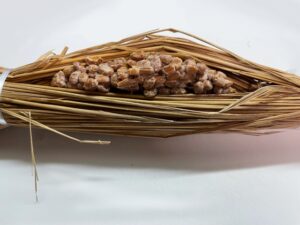history of natto

Natto is one of the fermented foods that symbolize Japanese food culture. Its characteristic stickiness and distinctive smell may divide people’s tastes, but its nutritional value and health benefits make it an indispensable food for Japanese people. How did natto first appear on Japanese dining tables and how did it develop? This article reviews the origin, history, and development of natto, and explains how natto continues to be loved today.
1 Origin and Development of Natto

The origin of natto is believed to date back to the agricultural society of ancient Japan. The exact origin of natto is not known, but the most popular theory is that natto was created by the spontaneous fermentation of soybeans after steaming. It is said that early natto was merely fermented soybeans.
Some believe that the spread of natto in Japan dates back to around the Heian period (794 – 1185). In ancient Japan, natto is believed to have been used by farmers as a very important preserved food. Fermentation made it possible to preserve it for long periods of time, and it was a valuable source of protein in times of crop failure. During the Edo period (1603-1867), natto’s food culture spread, and it is believed to have become an indispensable food on the tables of the common people.
2 Natto and its Popularization in the Edo Period

The Edo period (1603 – 1868) was a time of great development in Japanese food culture, and natto was one of those foods. During this period, natto began to be sold along the streets and spread further. Natto is rich in nutrients and flavor produced by fermentation, and was valued by merchants, artisans, and other busy people as a nutritious and easy-to-prepare food.
Natto was also so popular among the common people in the Edo period (1603-1867) that a business was established as “natto seller. During this period, variations of natto such as “Hiki-wari” and “koguri-natto” appeared, which is thought to have laid the foundation for the natto culture that continues to the present day.
3 Natto after the Meiji Period

Natto developed further after the Meiji Period (1868 – 1912). As Western culture entered Japan, natto’s distinctive smell and food culture sometimes made people avoid it, but its high nutritional value was reevaluated, and it gradually became more and more popular at home. Furthermore, the production method using the bacillus natto, the bacterium that ferments natto, was established, and natto began to spread commercially.
In the 20th century, mass production in factories became possible, making natto readily available to a larger number of people. Especially during the period of rapid economic growth after World War II, natto became a staple of breakfast in the busy Japanese diet and spread nationwide.
4 Natto’s Nutritional Value and Health Benefits

Natto is also known as a healthy food. In the process of fermenting soybeans, various health components such as “Nattokinase” produced by Bacillus natto, “polyphenols” and “dietary fiber” are increased. Nattokinase, in particular, is believed to prevent blood clots and is expected to improve blood flow.
Natto is also rich in high-quality vegetable protein contained in soybeans, B vitamins, calcium, and iron, making it a food with an excellent nutritional balance. These nutrients are believed to contribute to health maintenance, beauty, and immunity.
5 The Role of Natto in Modern Times

Even today, natto continues to be an indispensable ingredient in Japanese food culture. Natto is readily available in many supermarkets and convenience stores, making it an easy ingredient to include in the daily diet. Furthermore, natto is attracting attention not only in Japan but also around the world, and is increasingly being served in Japanese restaurants and healthy food stores overseas.
In addition, natto has been arranged in various ways to suit modern lifestyles. For example, recipes using natto and dishes that arrange natto have become the talk of the town on SNS and other social networking sites, proposing new ways to enjoy natto. Dishes that take advantage of natto’s stickiness and menus that emphasize natto’s healthiness have become popular among many people.
6 Inheritance and future of natto culture

Natto is a part of Japanese food culture that has been loved throughout the ages. Its appeal as a fermented food, its health benefits, and its deep history will continue to be passed on to many people. Especially with the growing interest in the health benefits of fermented foods, natto has the potential to become an increasingly popular food and spread further around the world.
Conclusion
Natto, with its unique flavor, texture, and deep history, will continue to be a symbol of Japanese food culture. It is hoped that the natto culture will be passed on to new generations so that even more people can enjoy the appeal of natto.
